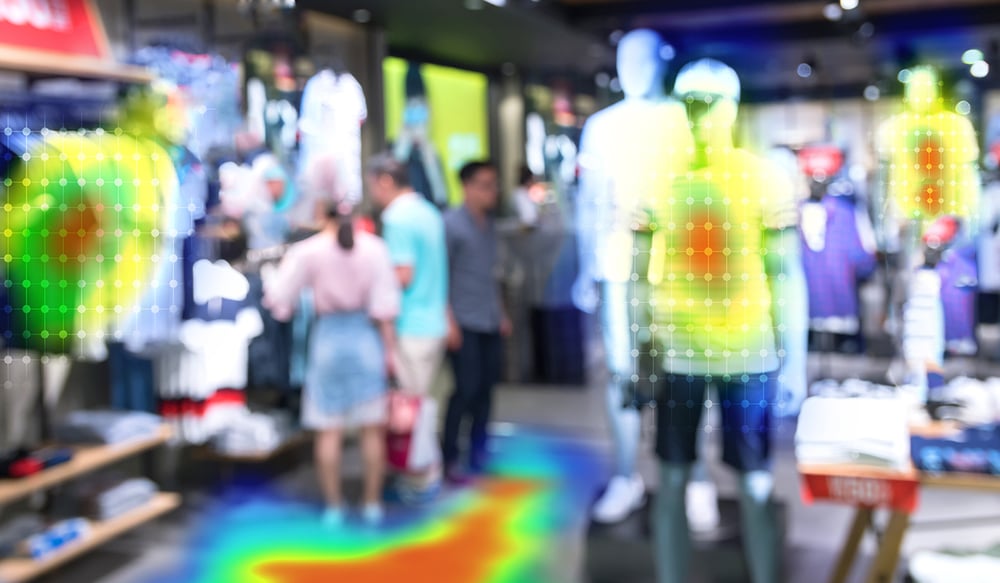Using Heat Mapping to Optimize Retail Displays & Boost Sales
Commercial Security Systems Dec 20, 2023 11:13:00 AM General Security 4 min read

Savvy retailers are always looking for ways to streamline processes, save on operation costs, and boost sales.
Once only available to large chain retailers, heat mapping has become much more affordable in recent years, empowering small and medium-sized businesses to also benefit from the technology.
Heat mapping shows where customers spend their time in your store, giving you the ability to identify hot and cold zones, optimize store layout, experiment with product location and retail displays, improve customer service, and align staffing with foot traffic trends—augmenting your store’s revenue generation.
Heat Mapping Identifies Hot & Cold Zones in Your Store
You may have an intuition where customers spend the most time throughout your store, but even if you're a diligent manager who takes notice of where shoppers tend to linger, you’re still playing the guessing game.
Plus, you're dedicating additional time on the sales floor that might be better employed elsewhere.
Heat mapping, on the other hand, enables you to accurately monitor all the hot and cold zones throughout your store and generate actionable reports. A crowd management technique relying on video analytics and color-coded images, heat mapping identifies the areas of a store that receive the most and the least customer attention and engagement, with red areas indicating high traffic while those on the blue end of the color spectrum signaling low engagement.
Heat mapping enables you to accurately monitor all the hot and cold zones throughout your store and generate actionable reports.
Although heat mapping can reveal hot spots and dead zones in your store, it doesn’t necessarily tell you why a particular spot is so popular or unappealing to customers. That’s up to you as a manager.
By cross-referencing merchandise in an area with total sales, or contrasting one retail display with another, you should be able to develop a clear sense of what works well and what doesn’t. For example, if you have the same product situated on two separate displays, but more shoppers hover near only one segment of shelves, then it may be the display’s location rather than its assortment of products that’s influencing customer behavior.
Employing Heat Maps to Test Merchandising Strategies & Optimize Store Layout
To create actionable insights based on heat-mapping data, you’ll need to run a variety of tests, including those of the A/B variety, moving merchandise around to different retail displays, redesigning the overall look of particular shelves, and even changing up entire sections to optimize store layout for seasonal promotions.
Here are some questions to consider when analyzing your heat-map data:
- Are visitors seeing important products in your store?
- How far down the aisles do they walk?
- How do they interact with other sections of your store?
- How do different days or seasons affect shopper behavior?
- How do particular layouts impact shopper behavior?
There are many ways to uncover why certain retail displays are or aren’t performing well, such as moving under-sold items from cold zones to hot zones, or vice versa, then examining the results.
Test different signage, lighting, and display designs. This might reveal how these elements influence customer attention and interest in a particular zone. For instance, you can vary the colors, fonts, or images to create a compelling contrast. Perhaps a display has a cold zone because your messaging is unappealing (or illegible) to shoppers.
Compare different days or seasons. Shoppers behave differently depending on the time of day or year. If certain retail zones were really “hot” during the same time last year, try moving undersold items there and see what comes of it. The same goes for weekends, holidays, or particular weather conditions.
Heat-mapping data will also reveal which retail displays or fixtures need to be moved to reduce bottlenecks or increase foot traffic near promotional products.
Some heat mapping technology can even determine when customers touch products on a shelf, a strong indicator of a likely purchase, giving you further insight into which retail displays are most effective at increasing sales.
Implement Heat Maps to Understand Staffing Needs & Improve Customer Service
Labor costs are usually the largest line item in a retail business' budget. And many store owners and managers really can’t afford to overstaff their sales floors. With heat mapping, you can align foot traffic with the appropriate number of staff.
Furthermore, you can identify which are peak points in the day when you’ll want to have more staff, and the lulls when you can get by with fewer employees on the sales floor.
Heat mapping can improve customer satisfaction, as well.
Since heat mapping shows where shoppers tend to stand in a given section of the store or where they typically enter an area, you can instruct employees where to position themselves so they can be more helpful to customers.
You can also employ heat mapping to track how long queues or wait times are for customer service or at checkout, enabling you to staff accordingly, thus, multiplying the number of customer transactions and sales per hour.
Bathrooms, benches, and entryways also factor in here, as well.
WIth heat mapping technology, you’ll know how frequently customer traffic enters any of these places. This is important for customer experience because store visitors expect all of these areas to remain clean and inviting. By integrating heat mapping into your technology stack, you will know how often you need employees to clean or reorganize key high-traffic areas throughout a given day.
Ultimately, heat mapping technology is about removing the guesswork from your business operations, enabling you to identify hot and cold zones in your store, effectively test out merchandising and layout strategies, understand staffing needs, and improve customer satisfaction.
General Security provides smart occupancy tracking, heat mapping, and other security technology to not only protect businesses of all sizes but boost their sales. Request a free quote today!
